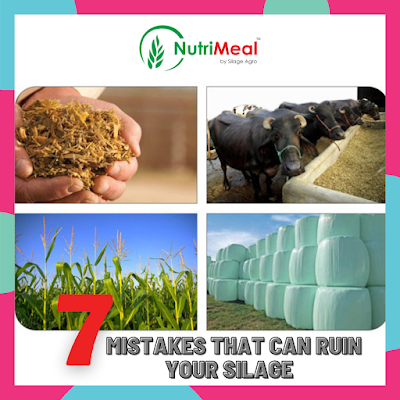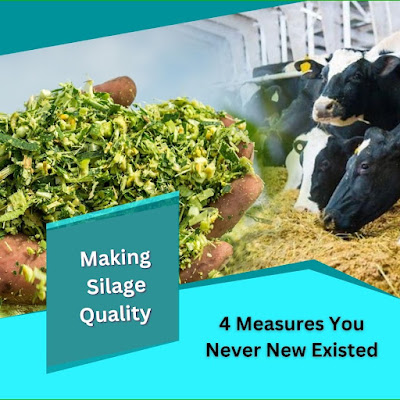7 Mistakes That Can Ruin Your Silage
Silage
has many benefits for dairy animals, such as higher milk production and good
health. But committing these seven mistakes will result in ineffective silage.
That's why Silage Agro Private Limited is sharing
these seven mistakes that we avoid as silage manufacturers, and so you should
too.
7 Mistakes That You Must Avoid Ruin Your
Silage
These
are the seven mistakes also known as silage sins. We at Silage Agro Private
Limited strongly advise you not to commit these sins to produce effective Silage
for Animals.
Leaving dead grass in the sward: - You cannot
stop mold growth in the grass, but you should do your best to reduce it in your
Silage Bales. It is strongly
advised to avoid leaving dead grass in the sward because any surplus grass left
unchecked will die and nourish mold and other unnecessary bacteria that will
remain until harvest.
Removing
extra grass can lead to less mold growth. You can remove this grass by topping
or grazing. Furthermore, studies have also shown that leaving surplus grass
reduces grass growth in the spring, resulting in less grass yield.
Harvesting grass that is over mature: - Another
horrible mistake that allows molds to invade your silage is harvesting grass
that is over mature. Sometimes this is unavoidable due to weather conditions,
or you need a mature low D value meal to feed certain animals such as dry
suckler cows. However, farmers usually do this to increase crop output even if
the quality is compromised.
The
issue with this practice is that as forage matures, the vegetative parts of the
crop die and become vulnerable to the fungal virus's growth. These are
invisible to the eye and will enable other fungi to rest on the forage,
increasing fungal propagules.
Leaving cut grass in a narrow swath to
wilt: - If you leave your cut grass in a narrow swath, this will again
lead to mold infection in your Wheat
Silage. Narrow swaths have a high density that
results in high temperature and humidity, enabling bacteria to survive. Additionally,
these swaths decrease wind efficiency in drying the crop.
We
recommend you spread your grass over 80 to 100% of the harvested area as soon
as possible after mowing, but you must ensure that this is done within 2 hours.
It will help in rapid wilting and also allow the sun to decrease mold growth.
Wrapping in the field: - We mentioned
what you should avoid preventing mold growth. So far, the remaining 4 points
talk about what not to do to prevent oxygen from feeding such mold. It is
strongly advised to wrap the bales as fast as possible, and you may think that
wrapping in the field is a good idea, but it can be risky.
The
first risk is holed getting punctured in the wrapped bale. If we drop it in the
field, this can be either by stones or stubbles. When you take such bales to
the stacking site, you can make the damage even worse. If this goes unnoticed,
then excess oxygen will enter the bale, increasing mold growth.
Not moving bales after wrapping: - We would
strongly advise you to take your wrapped bales to the stacking area as quickly
as possible, best within 2 hours. If it is not possible, then you should move
the bales within 8 hours.
However,
some farmers leave the bales for two weeks but moving the bales allows excess
oxygen. By grabbing your bales, you are squeezing the carbon dioxide out of the
bales creating a vacuum within which extra oxygen enters, leading to the growth
of unwanted bacteria.
Spiking a bale whether it's wrapped or
not: - You should never spike a bale whether it is wrapped or not. Some
of you may think that it's acceptable to spike an unwrapped bale to take it to
the wrapper. But this is disastrous. A bale is a densely packed lot of fodder
from which a lot of oxygen is already out. Spiking it results in oxygen
entering back, and you know the rest of the story. Furthermore, this creates
more holes while moving a spiked bale, leading to more problems. In short,
oxygen does its job of mold creation before it's used up after wrapping.
When
you spike a wrapped bale, you are puncturing a film that acts as an oxygen
barrier. Even if you patch the holes, these will not be as effective as the
original coating. It is advised to use a bail grab instead.
Not netting the bales: - You would
not want to let birds and vermin damage your silage bale created with hard
work, will you? But farmers still do not net the bales to give protection from
birds and vermin; these creatures won't even think once before damaging your
silage bales with holes. Instead, birds and vermin will either use feet or beaks
to puncture your well-wrapped bales.
So
why allow birds and vermin to damage your hard work? Instead, put a strong net
around your bales for protection against birds and vermin. It's that
simple.



Comments
Post a Comment